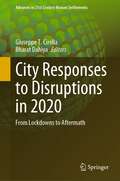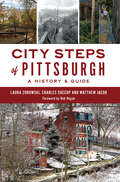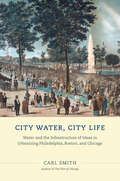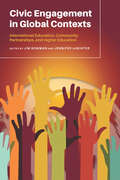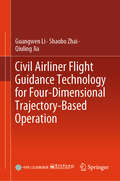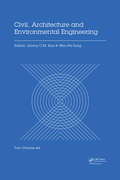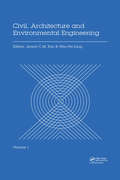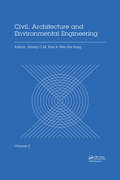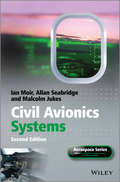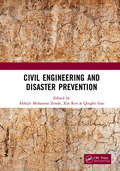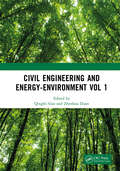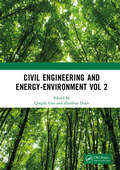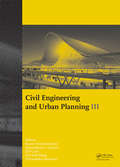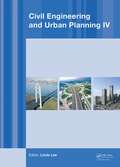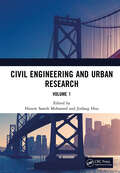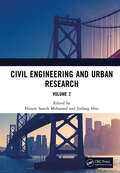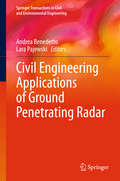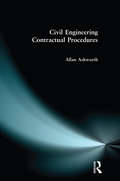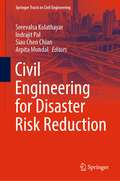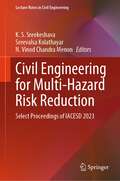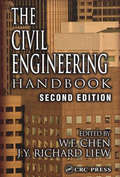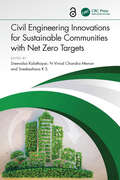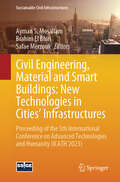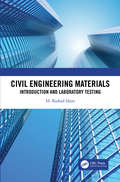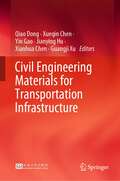- Table View
- List View
City Responses to Disruptions in 2020: From Lockdowns to Aftermath (Advances in 21st Century Human Settlements)
by Giuseppe T. Cirella Bharat DahiyaThis book presents the integrating of economics and urban geography to create a framework of cooperation around the idea of urban economic stability. It explores these disciplines through the economic lens and creates a collaborative environment for addressing the global challenges caused by the COVID-19 pandemic and future global shocks. Environmental advocates and proponents of economic growth are increasingly at odds—having looked at the economic impact of the decline of the environment as well as the environmental loss that occurs with unchecked growth and urbanization. The outbreak of the COVID-19 pandemic changed the global scene. The world shook in its foundations, as a number of countries’ lockdown affected not only the global economy but also society and the environment. The global community has seen the negative impact of COVID-19 on our economies. There have been steep declines in gross domestic product, job losses have been in the millions, and people have seen their incomes fall. An unplanned shutdown has taken its toll and has been a shock to the economies of the world. Past shocks and how they have impacted urban economies as well as for how long are core to bettering our understanding of present and future urban economic change. The underlying economic factors that make a shock more damaging to certain economies or industries, as well as understanding these vulnerabilities, help entities recover from economic shocks and allow them to better understand how impacts on individual businesses can be implemented. The pandemic revealed the need to adopt a global development approach, taking into consideration four dimensions: global value chains, debt, digitalization, and the environment. Topics related to the causation and lockdown are explored through a number of case studies from around the world.
City Steps of Pittsburgh: A History & Guide (History & Guide)
by Laura Zurowski Matthew JacobExploring Pittsburgh's Ups and Downs In Pittsburgh, the elevation varies wildly, fluctuating 660 feet from highest to lowest points throughout the area and making it one of the hilliest cities in the United States. Throughout this unruly and physically challenging landscape, the city's first mass transportation system was built - a steadily expanding network of public stairways, locally referred to as city steps, these flights of stairs are a throwback to a very different time in history and a very different Pittsburgh. Authors Laura Zurowski, Charles Succop and Matthew Jacob present the history of the Steel City steps and a walking guide to their scenic locations today.
City Water, City Life: Water and the Infrastructure of Ideas in Urbanizing Philadelphia, Boston, and Chicago
by Carl SmithA city is more than a massing of citizens, a layout of buildings and streets, or an arrangement of political, economic, and social institutions. It is also an infrastructure of ideas that are a support for the beliefs, values, and aspirations of the people who created the city. In "City Water, City Life," celebrated historian Carl Smith explores this concept through an insightful examination of the development of the first successful waterworks systems in Philadelphia, Boston, and Chicago between the 1790s and the 1860s. By examining the place of water in the nineteenth-century consciousness, Smith illuminates how city dwellers perceived themselves during the great age of American urbanization. aBut "City Water, City Life" is more than a history of urbanization. aIt is also a refreshing meditation on water as a necessity, as a resource for commerce and industry, and as an essentialOCoand centralOCopart of how we define our civilization.
Civic Engagement in Global Contexts: International Education, Community Partnerships, and Higher Education
by Jim Bowman Jennifer DeWinterThis volume examines the role of writing, rhetoric, and literacy programs and approaches in the practice of civic engagement in global contexts. Writing programs have experience in civic engagement and service learning projects in their local communities, and their work is central to developing students’ literacy practices. Further, writing programs compel student writers to attend to audience needs and rhetorical exigencies as well as reflect on their own subject positions. Thus, they are particularly situated to partner with other units on college campuses engaged in global partnerships. Civic Engagement in Global Contexts provides examples and evidence of the critical self-reflection and iteration with community partners that make these projects important and valuable. Throughout its thirteen chapters, this collection provides practical pedagogical and administrative approaches for writing studies faculty engaging with global learning projects, as well as nuanced insight into how to navigate contact zones from the planning stages of projects to the hard work of self-reflection and change. Partnerships and projects across national borders compel the field of rhetoric and composition to think through the ethics of writing studies program design and teaching practices. Doing this difficult work can disrupt presumptive notions of ownership that faculty and administrators hold concerning the fields involved in these projects and can even lead to decentering rhetoric/composition and other assumptions held by US-based institutions of higher education. Civic Engagement in GlobalContexts will be useful to instructors, advisors, and project managers of students in faculty-led project learning in overseas settings, international service learning through foreign study programs, and foreign study itself and to faculty members introducing civic engagement and community-based learning projects with foreign students in overseas institutions. Contributors: Olga Aksakalova, James Austin, Maria de Lourdes Caudillo Zambrano, Rebecca Charry Roje, Patricia M. Dyer, Tara E. Friedman, Bruce Horner, Kathryn Johnson Gindlesparger, Adela C. Licona, Ian Mauer, Joyce Meier, Susan V. Meyers, Sadia Mir, Stephen T. Russell
Civil Airliner Flight Guidance Technology for Four-Dimensional Trajectory-Based Operation
by Guangwen Li Shaobo Zhai Qiuling JiaThis book focuses on achieving precision guidance and timely arrival in flight. The content comprehensively describes the civil aircraft flight guidance technology for four-dimensional trajectory-based operation. The main content of this book is the summary of the author's team's research work on flight management systems and flight guidance technology over the past decade, including flight plan analysis and transition path construction, four-dimensional trajectory planning and re-planning, high-precision flight guidance commands calculation, FMS landing system, etc. The theoretical methods described in the book have been verified by pre-research and practical engineering projects, which are of great theoretical significance and engineering application value. This book is used as a reference for engineers engaged in flight control, flight guidance, and flight management research, as well as Masters and Ph.Ds. in related disciplines.
Civil, Architecture and Environmental Engineering: Proceedings of the International Conference ICCAE, Taipei, Taiwan, November 4-6, 2016
by Jimmy C.M. Kao Wen-Pei SungThis two-volume work contains the papers presented at the 2016 International Conference on Civil, Architecture and Environmental Engineering (ICCAE 2016) that was held on 4-6 November 2016 in Taipei, Taiwan. The meeting was organized by China University of Technology and Taiwan Society of Construction Engineers and brought together professors, researchers, scholars and industrial pioneers from all over the world. ICCAE 2016 is an important forum for the presentation of new research developments, exchange of ideas and experience and covers the following subject areas: Structural Science & Architecture Engineering, Building Materials & Materials Science, Construction Equipment & Mechanical Science, Environmental Science & Environmental Engineering, Computer Simulation & Computer and Electrical Engineering.
Civil, Architecture and Environmental Engineering Volume 1: Proceedings of the International Conference ICCAE, Taipei, Taiwan, November 4-6, 2016
by Jimmy C.M. Kao Wen-Pei SungThe 2016 International Conference on Civil, Architecture and Environmental Engineering (ICCAE 2016), November 4-6, 2016, Taipei, Taiwan, is organized by China University of Technology and Taiwan Society of Construction Engineers, aimed to bring together professors, researchers, scholars and industrial pioneers from all over the world. ICCAE 2016 is the premier forum for the presentation and exchange of experience, progress and research results in the field of theoretical and industrial experience. The conference consists of contributions promoting the exchange of ideas between researchers and educators all over the world.
Civil, Architecture and Environmental Engineering Volume 2: Proceedings of the International Conference ICCAE, Taipei, Taiwan, November 4-6, 2016
by Jimmy C.M. Kao Wen-Pei SungThe 2016 International Conference on Civil, Architecture and Environmental Engineering (ICCAE 2016), November 4-6, 2016, Taipei, Taiwan, is organized by China University of Technology and Taiwan Society of Construction Engineers, aimed to bring together professors, researchers, scholars and industrial pioneers from all over the world. ICCAE 2016 is the premier forum for the presentation and exchange of experience, progress and research results in the field of theoretical and industrial experience. The conference consists of contributions promoting the exchange of ideas between researchers and educators all over the world.
Civil Avionics Systems (Aerospace Series)
by Ian Moir Allan Seabridge Malcolm JukesCivil Avionics Systems, Second Edition, is an updated and in-depth practical guide to integrated avionic systems as applied to civil aircraft and this new edition has been expanded to include the latest developments in modern avionics. It describes avionic systems and potential developments in the field to help educate students and practitioners in the process of designing, building and operating modern aircraft in the contemporary aviation system. Integration is a predominant theme of this book, as aircraft systems are becoming more integrated and complex, but so is the economic, political and technical environment in which they operate. Key features: • Content is based on many years of practical industrial experience by the authors on a range of civil and military projects • Generates an understanding of the integration and interconnectedness of systems in modern complex aircraft • Updated contents in the light of latest applications • Substantial new material has been included in the areas of avionics technology, software and system safety The authors are all recognised experts in the field and between them have over 140 years’ experience in the aircraft industry. Their direct and accessible style ensures that Civil Avionics Systems, Second Edition is a must-have guide to integrated avionic systems in modern aircraft for those in the aerospace industry and academia.
Civil Engineering and Disaster Prevention: Proceedings of the 4th International Conference on Civil, Architecture and Disaster Prevention and Control (CADPC 2023), Suzhou, China, 24-26 March 2023
by Abhijit Mohanrao Zende Xin Ren Qingfei GaoCivil Engineering and Disaster Prevention focuses on the research of civil engineering, architecture and disaster prevention and control. These proceedings gather the most cutting-edge research and achievements, aiming to provide scholars and engineers with valuable research direction and engineering solutions. Subjects covered in the proceedings include: Civil Engineering Engineering Structure Architectural Materials Disaster Prevention and Control Building Electrical Engineering The works of these proceedings aim to promote the development of civil engineering and environment engineering. Thereby, fostering scientific information interchange between scholars from the top universities, research centers and high-tech enterprises working all around the world.
Civil Engineering and Energy-Environment Vol 1: Proceedings of the 4th International Conference on Civil Engineering, Environment Resources and Energy Materials (CCESEM 2022), Sanya, China, 21-23 October 2022
by Qingfei Gao Zhenhua DuanCivil Engineering and Energy-Environment focuses on the research of civil engineering, environment resources and energy materials. This proceedings gathers the most cutting-edge research and achievements, aiming to provide scholars and engineers with preferable research direction and engineering solution as reference. Subjects in this proceedings include: - Engineering Structure- Environmental Protection Materials- Architectural Environment ·Environment Resources- Energy Storage- Building Electrical Engineering The works of this proceedings will promote development of civil engineering and environment engineering. Thereby, promote scientific information interchange between scholars from top universities, research centers and high-tech enterprises working all around the world.
Civil Engineering and Energy-Environment Vol 2: Proceedings of the 4th International Conference on Civil Engineering, Environment Resources and Energy Materials (CCESEM 2022), Sanya, China, 21-23 October 2022
by Qingfei Gao Zhenhua DuanCivil Engineering and Energy-Environment focuses on the research of civil engineering, environment resources and energy materials. This proceedings gathers the most cutting-edge research and achievements, aiming to provide scholars and engineers with preferable research direction and engineering solution as reference. Subjects in this proceedings include: - Engineering Structure- Environmental Protection Materials- Architectural Environment ·Environment Resources- Energy Storage- Building Electrical Engineering The works of this proceedings will promote development of civil engineering and environment engineering. Thereby, promote scientific information interchange between scholars from top universities, research centers and high-tech enterprises working all around the world.
Civil Engineering and Urban Planning III
by Kouros Mohammadian Konstadinos G. Goulias Elif Cicek Jieh-Jiuh Wang Chrysanthos MaraveasCivil Engineering and Urban Planning III addresses civil engineering and urban planning issues associated with transportation and the environment. The contributions not only highlight current practices in these areas, but also pay attention to future research and applications, and provide an overview of the progress made in a wide variety of topics
Civil Engineering and Urban Planning IV: Proceedings of the 4th International Conference on Civil Engineering and Urban Planning, Beijing, China, 25-27 July 2015
by Yuan-Ming Liu Dong Fu Zhen-Xin Tong Zhi-Qing Baox Bin TangCivil Engineering and Urban Planning IV includes the papers presented at the 4th International Conference on Civil Engineering and Urban Planning (CEUP 2015, Beijing, China, 25-27 July 2015). The contributions from experts and world-renowned scientists cover a wide variety of topics: - Civil engineering;- Architecture and urban planning; - Transpor
Civil Engineering and Urban Research, Volume 1: Proceedings of the 4th International Conference on Civil Architecture and Urban Engineering (ICCAUE 2022), Xining, China, 24–26 June 2022
by Hazem Samih Mohamed Jinfang HouCivil Engineering and Urban Research collects papers resulting from the conference on Civil, Architecture and Urban Engineering (ICCAUE 2022), Xining, China, 24–26 June 2022. The primary goal is to promote research and developmental activities in civil engineering, architecture and urban research. Moreover, it aims to promote scientific information interchange between scholars from the top universities, business associations, research centers and high-tech enterprises working all around the world. The conference conducts in-depth exchanges and discussions on relevant topics such as civil engineering and architecture, aiming to provide an academic and technical communication platform for scholars and engineers engaged in scientific research and engineering practice in the field of urban engineering, civil engineering and architecture design. By sharing the research status of scientific research achievements and cutting-edge technologies, it helps scholars and engineers all over the world comprehend the academic development trend and broaden research ideas. So as to strengthen international academic research, academic topics exchange and discussion, and promote the industrialization cooperation of academic achievements.
Civil Engineering and Urban Research, Volume 2: Proceedings of the 4th International Conference on Civil Architecture and Urban Engineering (ICCAUE 2022), Xining, China, 24–26 June 2022
by Hazem Samih Mohamed Jinfang HouCivil Engineering and Urban Research collects papers resulting from the conference on Civil, Architecture and Urban Engineering (ICCAUE 2022), Xining, China, 24–26 June 2022. The primary goal is to promote research and developmental activities in civil engineering, architecture and urban research. Moreover, it aims to promote scientific information interchange between scholars from the top universities, business associations, research centers and high-tech enterprises working all around the world. The conference conducts in-depth exchanges and discussions on relevant topics such as civil engineering and architecture, aiming to provide an academic and technical communication platform for scholars and engineers engaged in scientific research and engineering practice in the field of urban engineering, civil engineering and architecture design. By sharing the research status of scientific research achievements and cutting-edge technologies, it helps scholars and engineers all over the world comprehend the academic development trend and broaden research ideas. So as to strengthen international academic research, academic topics exchange and discussion, and promote the industrialization cooperation of academic achievements.
Civil Engineering Applications of Ground Penetrating Radar (Springer Transactions in Civil and Environmental Engineering)
by Andrea Benedetto Lara PajewskiThis book, based on Transport and Urban Development COST Action TU1208, presents the most advanced applications of ground penetrating radar (GPR) in a civil engineering context, with documentation of instrumentation, methods and results. It explains clearly how GPR can be employed for the surveying of critical transport infrastructure, such as roads, pavements, bridges and tunnels and for the sensing and mapping of underground utilities and voids. Detailed attention is also devoted to use of GPR in the inspection of geological structures and of construction materials and structures, including reinforced concrete, steel reinforcing bars and pre/post-tensioned stressing ducts. Advanced methods for solution of electromagnetic scattering problems and new data processing techniques are also presented. Readers will come to appreciate that GPR is a safe, advanced, non destructive and noninvasive imaging technique that can be effectively used for the inspection of composite structures and the performance of diagnostics relevant to the entire life cycle of civil engineering works.
Civil Engineering Contractual Procedures
by Allan AshworthCivil Engineering Contractual Procedures gives an introduction to the contractual procedures, legislation and administrative practices that are used in the civil engineering industry. It introduces the principles of contract law, and the main forms of contract used in the construction industry. It then concentrates on the main forms of contract used in civil engineering, with the discussion based on the ICE Conditions of Contract. It looks at the obligations of the various parties to the contract under all the clauses of the contract.Civil Engineering Contractual Procedures provides a sound basis for anyone seeking an understanding of the contractual administration of civil engineering projects. It is an essential core text for all students of civil engineering and related courses at both undergraduate and higher technician levels. It will also be a useful reference source for those already working in the industry.
Civil Engineering for Disaster Risk Reduction (Springer Tracts in Civil Engineering)
by Sreevalsa Kolathayar Indrajit Pal Siau Chen Chian Arpita MondalThe book is a comprehensive volume on multi-hazards and their management for a sustainable built environment. It focuses on the role of civil engineering in building disaster resilient society. This book brings together all diverse disciplines of civil engineering and related areas (for example, geotechnical engineering, water resources engineering, structural engineering, transportation engineering, environmental engineering, construction management, GIS, and remote sensing) towards a common goal of disaster resilience through an interdisciplinary approach. It contains methods and case studies focusing on civil engineering solutions to reduce the disaster risk. The book contents are aligned in line with the priorities set by UN-Sendai Framework for Disaster Risk Reduction and UN-SDGs to promote a global culture of risk-awareness and disaster reduction. The book will be a useful comprehensive reference for disaster risk reduction beneficial for engineering students, teaching faculty, researchers, industry professionals and policymakers.
Civil Engineering for Multi-Hazard Risk Reduction: Select Proceedings of IACESD 2023 (Lecture Notes in Civil Engineering #457)
by K. S. Sreekeshava Sreevalsa Kolathayar N. Vinod Chandra MenonThis book presents select proceedings of the International Conference on Interdisciplinary Approaches in Civil Engineering for Sustainable Development (IACESD 2023) hosted under the aegis of the Group of Twenty (G20) and Civil 20 (C20) at Jyothy Institute of Technology, Bengaluru, India. The topics covered include sustainable and resilient communities, sustainable construction materials, disaster resilient infrastructure, nano-composites and bio-composites, sustainable geotechnics and earthquake engineering. This book serves as a resource material for researchers and industry professionals interested in disaster risk reduction.
The Civil Engineering Handbook (New Directions in Civil Engineering)
by W. F. Chen J.Y. Richard LiewProviding extensive coverage of all major areas of civil engineering, the second edition of this award-winning handbook features contributions from leading professionals and academicians and is packed with formulae, data tables, and definitions, vignettes on topics of recent interest, and additional sources of information. It includes a wealth of material in areas such as coastal engineering, polymeric materials, computer methods, shear stresses in beams, and pavement performance evaluation. Its wide range of information makes it an essential resource for anyone working in civil, structural, or environmental engineering.
Civil Engineering Innovations for Sustainable Communities with Net Zero Targets
by Sreevalsa Kolathayar N Vinod Chandra Menon Sreekeshava K SThis volume on civil engineering innovations for sustainable communities with net zero targets aligns with the United Nations sustainable development goals in the context of civil engineering innovations. Major topics covered include hydrological alterations under climate change, smart water management, sustainable slope stability solutions, sustainable water management and climate-smart agriculture, conservation of wetlands, influence of phase change materials on thermal properties, building information modeling (BIM) for sustainable and affordable construction, and so forth.Features: Combines concepts of civil engineering and sustainable development for future infrastructures Includes hydrological alterations under climate change impacts Covers prudent fiduciary discipline and effective cost management in the construction of buildings and critical infrastructure Discusses BIM and cost-effective sustainable construction Reviews hybrid artificial intelligence in civil infrastructure to attain SDGs #9 (industry, innovation and infrastructure) and #11 (sustainable cities and communities) This book is aimed at graduate students and researchers in civil engineering, sustainable development, risk management, GIS, and water.The Open Access version of this book, available at http://www.taylorfrancis.com, has been made available under a Creative Commons [Attribution-Non Commercial-No Derivatives (CC-BY-NC-ND)] 4.0 license.
Civil Engineering, Material and Smart Buildings: Proceeding of the 5th International Conference on Advanced Technologies and Humanity (ICATH'2023) (Sustainable Civil Infrastructures)
by Ayman S. Mosallam Brahim El Bhiri Safae MerzoukAs cities continue to grow and evolve, the challenges of building sustainable, resilient, and efficient urban environments have never been greater. This comprehensive volume presents cutting-edge research and innovative solutions in the fields of construction, materials science, and civil engineering. With contributions from leading experts and researchers, this book explores the transformative role of new technologies, sustainable materials, and advanced methodologies in shaping the future of cities worldwide. Part 1: New Ideas and Innovations in City Structures showcases groundbreaking research in areas such as manganese enrichment from mining tailings, the integration of machine learning in civil engineering, and the harmonious blend of mathematics and aesthetics in urban design through Moroccan and Andalusian tiling. These innovations push the boundaries of what’s possible in urban planning and construction, offering insights into the future of city development. Part 2: Construction and Materials delves into the practical applications and challenges of using sustainable materials like Ferrock concrete, recycled asphalt pavement, and fiber-reinforced polymers (FRP) for structural reinforcement. With a focus on durability and environmental impact, this section provides a thorough review of current best practices and emerging technologies that promise to revolutionize the construction industry. Part 3: Testing and Technologies in Urban Infrastructure highlights the latest testing techniques and technologies used to evaluate and improve the safety, efficiency, and sustainability of urban buildings and infrastructure. From seismic performance in reinforced concrete structures to the development of zero-energy buildings, this section offers a detailed analysis of the cutting-edge methods that are driving innovation in modern cityscapes. This book is an essential resource for professionals, researchers, and students in civil engineering, urban planning, and materials science. By exploring both theoretical concepts and real-world applications, " Civil Engineering, Material, and Smart Buildings: New Technologies in Cities' Infrastructures" provides valuable insights into the future of urban construction and the key technologies that will shape the cities of tomorrow.
Civil Engineering Materials: Introduction and Laboratory Testing
by M. Rashad IslamCivil Engineering Materials: Introduction and Laboratory Testing discusses the properties, characterization procedures, and analysis techniques of primary civil engineering materials. It presents the latest design considerations and uses of engineering materials as well as theories for fully understanding them through numerous worked mathematical examples. The book also includes important laboratory tests which are clearly described in a step-by-step manner and further illustrated by high-quality figures. Also, analysis equations and their applications are presented with appropriate examples and relevant practice problems, including Fundamentals of Engineering (FE) styled questions as well those found on the American Concrete Institute (ACI) Concrete Field Testing Technician - Grade I certification exam. Features: Includes numerous worked examples to illustrate the theories presented Presents Fundamentals of Engineering (FE) examination sample questions in each chapter Reviews the ACI Concrete Field Testing Technician - Grade I certification exam Utilizes the latest laboratory testing standards and practices Includes additional resources for instructors teaching related courses This book is intended for students in civil engineering, construction engineering, civil engineering technology, construction management engineering technology, and construction management programs.
Civil Engineering Materials for Transportation Infrastructure
by Qiao Dong Xueqin Chen Yin Gao Jianying Hu Xianhua Chen Guangji XuThis book aims to introduce the knowledge, tests, and designs of materials in civil engineering. The scope of this book includes the fundamental mechanical and physical properties of materials; properties, tests, and gradation designs of aggregates; production, composition, hydration, properties, and tests of lime and cement; composition, tests, and design of cement concrete; mechanisms, properties, and design of inorganic binder stabilized material; properties, tests, and grading of asphalt; composition, properties, tests, and designs of asphalt mixture; and properties, treatments, tests, and selections of steel. This book can be used as a textbook or a reference book for undergraduate students, graduate students, and professionals in the field of civil, pavement, bridge, geotechnical, and environmental engineering. In this book, many charts on the key properties are used to help explain the mechanisms of materials. Step-by-step examples are presented to help understand both the knowledge and practices of material design such as the aggregate gradation design, cement concrete design, asphalt grading, and asphalt mixture design. The tests, designs, and specifications of civil engineering materials in China are introduced in detail.
